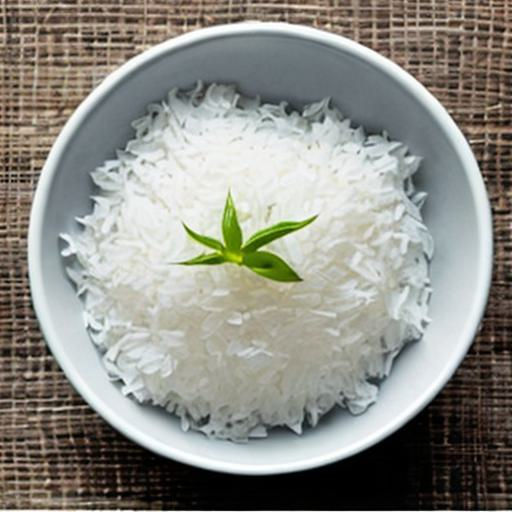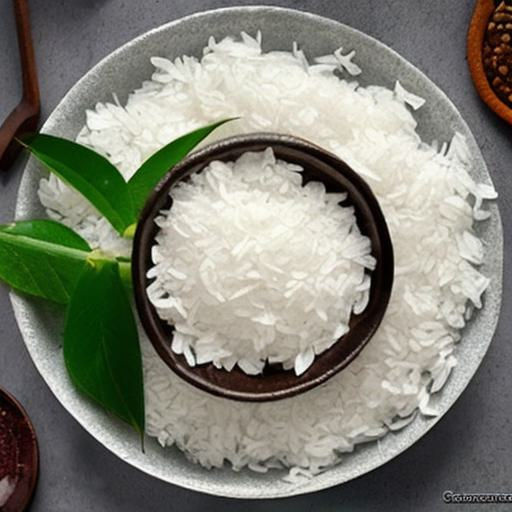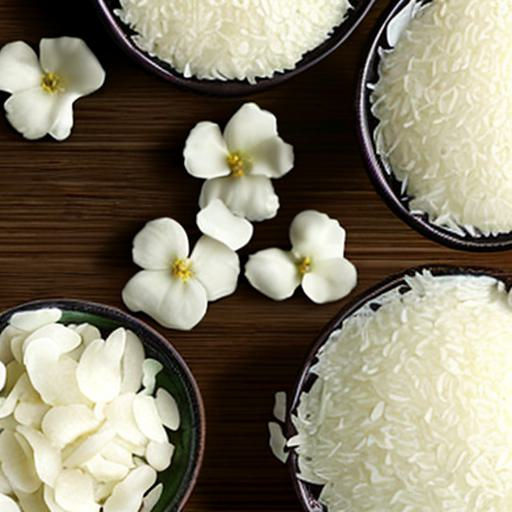Jasmine Rice Nutrition Profile
- Muhammad Riaz

- Jul 31, 2023
- 8 min read
Updated: Aug 12, 2023

Welcome to our deep dive into the world of "jasmine rice nutrition". If you're a rice lover, then you're likely familiar with jasmine rice – the fragrant, fluffy grain that’s the perfect accompaniment to a myriad of dishes. But beyond its tantalizing aroma and delightful taste, have you ever wondered about the nutritional aspects of this popular grain?
Understanding the nutritional value of the food we consume is a key part of maintaining a healthy and balanced diet. Today, we're putting jasmine rice under the nutritional microscope. We'll explore its nutrient profile, how it compares to other types of rice, and the health benefits it offers. Additionally, we’ll share tips on how you can incorporate jasmine rice into a balanced diet.
So, whether you're a nutrition enthusiast, a curious home cook, or simply someone who enjoys a good plate of jasmine rice, this post has something for you. Join us as we unravel the nutritional secrets of this delightful grain, using our targeted keyword – "jasmine rice nutrition".
What is Jasmine Rice?

Named after the sweet-smelling jasmine flower, jasmine rice is a type of long-grain rice renowned for its fragrant aroma and slightly sticky texture when cooked. This highly sought-after grain hails from Thailand – specifically, the verdant paddy fields of the country's northeastern plateau. Yet, it's not confined to Thai cuisine; it has found its way into the culinary traditions of numerous cultures around the globe.
As you delve deeper into "jasmine rice nutrition", you'll find that its popularity isn't solely due to its delightful scent and taste. This rice variety also has an interesting nutritional profile that makes it a smart choice for those looking to maintain a healthy diet.
The allure of jasmine rice lies in its unique qualities. When cooked, its grains fluff up beautifully yet cling together slightly, a balance that's essential in dishes where rice needs to absorb delicious sauces and flavors. Plus, it boasts a subtle floral and buttery flavor, making it the perfect companion to spicy, sour, or flavorful dishes.
Moreover, jasmine rice isn't a one-size-fits-all category. There's white jasmine rice, which is milled to remove the husk, bran, and germ, resulting in a refined, white grain. Then, there's the less processed brown jasmine rice, which retains its bran layer, giving it a nuttier flavor, chewier texture, and more robust "jasmine rice nutrition" profile.
As we peel back the layers of jasmine rice's appealing characteristics, we begin to understand why it's such a staple in kitchens around the world. Stay with us as we journey further into the world of "jasmine rice nutrition".
Nutritional Profile of Jasmine Rice
Jasmine rice, like other varieties of rice, is primarily a source of carbohydrates. However, a closer look at its nutritional profile underlines that it has more to offer in terms of "jasmine rice nutrition". Let's delve into the nutrient breakdown for one cup of cooked white jasmine rice:
Calories: Approximately 205
Carbohydrates: 45 grams
Protein: 4 grams
Fat: Less than 1 gram
Fiber: 1 gram
Small amounts of calcium, iron, vitamin B6, and magnesium
As mentioned earlier, jasmine rice also comes in a brown version. Brown jasmine rice retains its bran layer, which houses a significant portion of its nutrients. Consequently, brown jasmine rice has a slightly different nutritional profile, including more fiber and certain vitamins and minerals.
One cup of cooked brown jasmine rice typically provides:
Calories: Approximately 216
Carbohydrates: 45 grams
Protein: 5 grams
Fat: 2 grams
Fiber: 3.5 grams
Higher amounts of calcium, iron, vitamin B6, and magnesium compared to white jasmine rice
Understanding the "jasmine rice nutrition" profile allows us to appreciate this grain beyond its fragrant aroma and delightful taste. It's a source of essential nutrients that contribute to a balanced diet. In the next section, we will explore how these nutrients translate into health benefits.
Jasmine Rice vs Basmati Rice Nutritional Profile
When exploring the world of aromatic rices, the two standout varieties are often jasmine and basmati. Both are cherished for their fragrant aroma, delightful taste, and distinct textures. However, when it comes to "jasmine rice nutrition" and "basmati rice nutrition", how do they compare?
First, let's take a look at the nutritional profile of 1 cup of cooked white jasmine rice:
Calories: Approximately 205
Carbohydrates: 45 grams
Protein: 4 grams
Fat: Less than 1 gram
Fiber: 1 gram
Small amounts of calcium, iron, vitamin B6, and magnesium
Now, let's compare that with the nutritional profile of 1 cup of cooked white basmati rice:
Calories: Approximately 210
Carbohydrates: 45 grams
Protein: 5 grams
Fat: 0.5 grams
Fiber: 1 gram
Similar amounts of calcium, iron, vitamin B6, and magnesium
At a glance, jasmine and basmati rice have quite similar nutritional profiles. The differences are minor; basmati rice has slightly more protein and slightly fewer calories than jasmine rice. The carbohydrate, fat, and fiber contents are quite comparable.
However, these profiles can change when we compare brown jasmine rice and brown basmati rice, which retain their bran layers and hence have more nutrients and fiber.
Understanding "jasmine rice nutrition" and "basmati rice nutrition" allows us to make informed decisions about which grain to use, depending on our dietary needs and the specific nutrients we are looking for. While both grains are nutritious and make for an excellent staple, their subtle nutritional differences may cater to different dietary requirements.
This section offers a detailed comparison of jasmine rice and basmati rice, using the keywords "jasmine rice nutrition" and "basmati rice nutrition". It highlights the slight differences between the two popular grains. Let me know if there are any changes you'd like.
Health Benefits of Jasmine Rice

Understanding "jasmine rice nutrition" helps us unveil the multiple health benefits this flavorful grain brings to our plates. Let's take a look at what this humble grain has to offer:
1. Good Source of Energy: Jasmine rice is primarily composed of carbohydrates, the body's main source of energy. This makes it a good choice for individuals needing quick energy, such as athletes or those with physically demanding jobs.
2. Low in Fat: Jasmine rice is very low in fat, which makes it a suitable option for individuals trying to limit their fat intake.
3. Provides Essential Vitamins and Minerals: Though not a significant source, jasmine rice does provide small amounts of calcium, iron, vitamin B6, and magnesium, essential for various bodily functions.
4. Gluten-Free: Like all rice varieties, jasmine rice is naturally gluten-free, making it a great grain choice for those with celiac disease or gluten intolerance.
When it comes to brown jasmine rice, the health benefits increase due to the retained bran layer:
5. High in Fiber: Brown jasmine rice contains more fiber compared to white jasmine rice. Fiber aids in digestion, helps control blood sugar levels, and can support weight management by promoting feelings of fullness.
6. Contains Antioxidants: The bran layer in brown jasmine rice contains antioxidants, compounds that protect your cells from damage and may reduce the risk of chronic diseases.
7. More Nutrient-Rich: Brown jasmine rice contains more vitamins and minerals than white jasmine rice due to the intact bran layer.
Remember, while jasmine rice has its health benefits, it's best enjoyed as part of a balanced diet. Different grains bring different nutrients to the table, and a variety of food will ensure a mix of essential nutrients.
Jasmine Rice vs Other Rice Varieties
There's a diverse array of rice varieties out there, each with its unique attributes. Understanding these differences can help us appreciate how "jasmine rice nutrition" stacks up against other popular types.
1. Jasmine vs Basmati Rice: As we've already discussed in depth, Jasmine and Basmati rice have similar nutritional profiles. However, they do have a slightly different flavor and texture. Jasmine rice is a bit stickier and has a subtle floral aroma, while basmati rice has a more distinct nutty flavor and a firmer, fluffier texture when cooked.
2. Jasmine vs Brown Rice: Comparing Jasmine rice to general brown rice (not brown Jasmine rice), we find similar nutritional content. However, brown rice typically has more fiber due to the retained bran layer. Flavor-wise, brown rice tends to have a more earthy, nutty flavor compared to the subtle floral and buttery notes of Jasmine rice.
3. Jasmine vs White Rice: White Jasmine rice, while a type of white rice, stands out with its aromatic quality. In terms of nutrition, white Jasmine rice and other kinds of white rice are quite similar, with white Jasmine rice often having a slightly higher protein content.
4. Jasmine vs Wild Rice: Wild rice, not a true rice but a type of grass, has a more robust nutritional profile than Jasmine rice. It has fewer carbs but more protein and fiber. It's also rich in B vitamins and several minerals. In terms of texture and flavor, wild rice is chewier and has a strong, nutty flavor.
5. Jasmine vs Black Rice: Black rice, also known as forbidden rice, has a high antioxidant content, thanks to its dark color. It has similar amounts of carbohydrates as Jasmine rice but more protein and fiber. Black rice also has a unique nutty flavor and a striking deep purple, almost black, color when cooked.
While Jasmine rice holds its own with its distinct aroma and taste, every rice variety has something unique to offer. A diverse diet including a variety of grains allows you to enjoy a wide array of flavors and nutritional benefits.
How to Incorporate Jasmine Rice into a Healthy Diet
Jasmine rice, with its fragrant aroma and delicate flavor, is a versatile grain that can be easily incorporated into a healthy diet. Let's explore some ways you can enjoy "jasmine rice nutrition" as part of your daily meals:
1. Balanced Plate: Use jasmine rice as the carbohydrate portion of your meal. Pair it with lean proteins like chicken, fish, or tofu, and a variety of colorful vegetables for a balanced, nutritious plate.
2. Whole Grain Option: Opt for brown jasmine rice for a whole grain choice. It provides more fiber and nutrients compared to white jasmine rice due to the retained bran layer.
3. Stir-Fry: Jasmine rice is perfect for making fried rice. Stir fry it with an array of vegetables, lean protein, and a low-sodium sauce for a healthy, quick meal.
4. Soups and Stews: Add cooked jasmine rice to soups and stews for extra body and heartiness. This is an excellent way to make your meal more filling.
5. Stuffed Vegetables: Cooked jasmine rice can be mixed with other ingredients like lean ground meat, vegetables, and spices to stuff bell peppers, tomatoes, or zucchinis for a healthy and flavorful dish.
6. Salads: Cold jasmine rice can be added to salads for extra texture and to help you feel full longer.
7. Portion Control: While jasmine rice is nutritious, it's also high in carbohydrates and can be easy to overeat. Be mindful of portion sizes; a serving is usually about 1/2 cup of cooked rice.
8. Experiment with Recipes: Jasmine rice can be used in a variety of cuisines, not just Asian recipes. Try it in Latin, Middle Eastern, or even Italian dishes - it's versatility might surprise you!
Incorporating jasmine rice into your diet can add variety to your meals while also contributing valuable nutrients. Remember, balance and variety are key to a healthy diet, so try to include many different types of grains, not just rice, in your meal planning.
Conclusion
Rice is a staple food for billions of people around the world, and for a good reason. With its versatility and a range of health benefits, it's an excellent addition to a balanced diet. Jasmine rice, specifically, offers unique flavor, aroma, and a decent array of nutrients, making it a standout variety.
Understanding "jasmine rice nutrition" allows us to appreciate this humble grain even more. While jasmine rice is delicious and nutritious in its own right, it's important to remember that variety is key. By including a wide range of grains in our diet, we can ensure that we're getting a spectrum of nutrients needed for optimal health.
Whether you enjoy your Jasmine rice in a flavorful stir-fry, a hearty soup, or as a side to a lean protein, it’s a delightful way to enhance your meals. Remember to check out our selection of high-quality Jasmine rice at your website Get a Quote. Happy cooking!




Opmerkingen